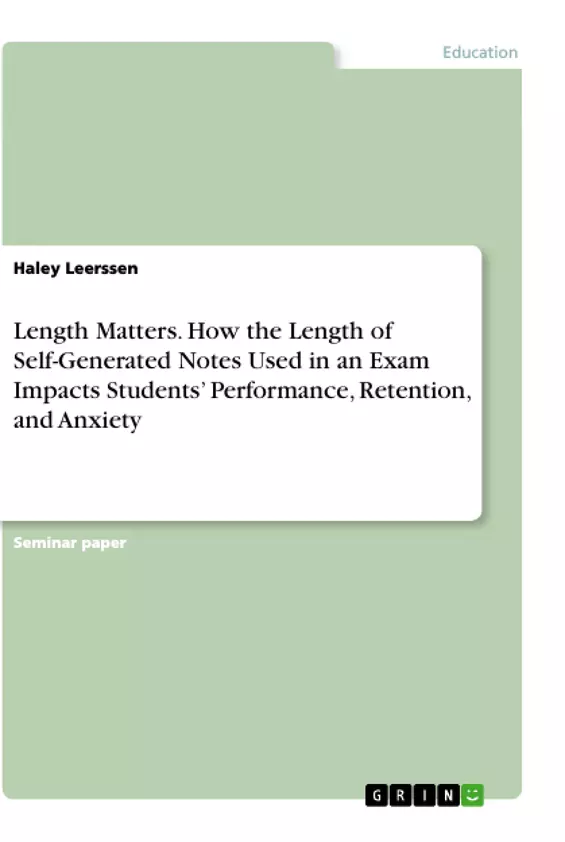Compared to Closed-Book, Open-Book and single page Cheat-Sheet examination forms, utilizing Limited Notes on a social studies exam improves middle schoolers’ performance and retention while lowering test anxiety.
In the midst of the COVID-19 pandemic, educators are forced to consider new evaluation forms because social distancing regulations have made traditional in-presence examinations less viable. This paper proposes that one such form, the LN examination, is superior to the previously researched CB, OB, and CS examination forms in terms of higher performance and retention as well as lower test anxiety. Students may perform better on an LN exam for a variety of reasons. This includes the likely increase in time spent studying and reviewing before an exam due to the requirements and parameters of preparing LN. A decrease in time spent searching through LN compared to OB during the exam should also provide superior performance.
Furthermore, with the implementation of LN, examiners will be freer to generate more practical questions that test students’ understanding and application abilities rather than rely on multiple choice and rote learning. An increase in performance in such exams with LN is expected compared to CB. This performance increase will likely only grow over time as students become familiar with studying for such reasoning- and application-based questions typical to an LN exam. Performance would further be increased due to the anticipated lowering of anxiety on such an examination type. Anxiety could conceivably be lower in the LN condition because students have access to all of the necessary material without needing to spend as much time and energy searching for the relevant information in their notes. Also, they may be comforted by the knowledge that they have much of the relevant material close at hand, further decreasing anxiety. Finally, long-term retention of the material could also be anticipated because the production of comprehensive LN likely increases memory coding of the material as well as decreasing dependency. The following study proposal suggests a comprehensive approach to test how the length of authorized notes affects middle school students’ performance, retention, and anxiety in a social studies exam.
Inhaltsverzeichnis (Table of Contents)
- Introduction
- Performance
- Retention
- Test Anxiety
- Discussion
- References
Zielsetzung und Themenschwerpunkte (Objectives and Key Themes)
This paper aims to explore the impact of authorized notes in exams on student performance, retention, and anxiety levels. Specifically, it focuses on the length of self-generated notes, comparing a Limited Notes (LN) condition with one page and four pages of notes, to Open-Book (OB), Closed-Book (CB), and Cheat-Sheet (CS) exam formats. The research examines how different note lengths influence student learning and test-taking strategies, drawing on existing literature and proposing a novel approach for assessing student understanding.
- Impact of note length on exam performance
- Relationship between note length and student retention
- Influence of note length on test anxiety levels
- Comparison of Limited Notes with Open-Book, Closed-Book, and Cheat-Sheet exam formats
- Application of these findings to a specific subject (social studies) and age group (middle schoolers)
Zusammenfassung der Kapitel (Chapter Summaries)
Introduction
This chapter introduces the ongoing debate surrounding Open-Book (OB) and Closed-Book (CB) exams, highlighting the growing relevance of alternative exam forms in the current educational context. It outlines the arguments for and against traditional CB exams, introducing the concept of Cheat-Sheet (CS) exams and highlighting their potential benefits and drawbacks. This chapter then proposes the investigation of a new exam format: Limited Notes (LN), suggesting a four-page length as an ideal balance between sufficient space and strategic note-taking.
Performance
This chapter reviews existing research on the impact of authorized note pages on exam performance, highlighting studies that support the Coding Hypothesis (benefit of note preparation) and the Dependency Hypothesis (potential harm of relying on notes). It also discusses studies comparing CS, CB, and OB exams, showing mixed results and highlighting the need for further investigation into the effectiveness of different exam formats.
Retention
This chapter examines the influence of note preparation on student retention, exploring how the act of creating notes can facilitate encoding information into memory but also lead to dependence on the material. It highlights research findings suggesting that students may study less for OB exams compared to CB exams, potentially impacting their performance. The chapter introduces the concept of Limited Notes (LN) as a potential solution to address this issue, encouraging students to spend more time preparing and reviewing relevant material.
Schlüsselwörter (Keywords)
This paper explores the impacts of the length of self-generated notes on students' performance, retention, and anxiety, focusing on the comparison between Limited Notes (LN), Open-Book (OB), Closed-Book (CB), and Cheat-Sheet (CS) exam formats. The research examines note-taking strategies, learning processes, and the effectiveness of different evaluation methods in a specific subject (social studies) and age group (middle schoolers).
- Arbeit zitieren
- Haley Leerssen (Autor:in), 2021, Length Matters. How the Length of Self-Generated Notes Used in an Exam Impacts Students’ Performance, Retention, and Anxiety, München, GRIN Verlag, https://www.grin.com/document/1167344



